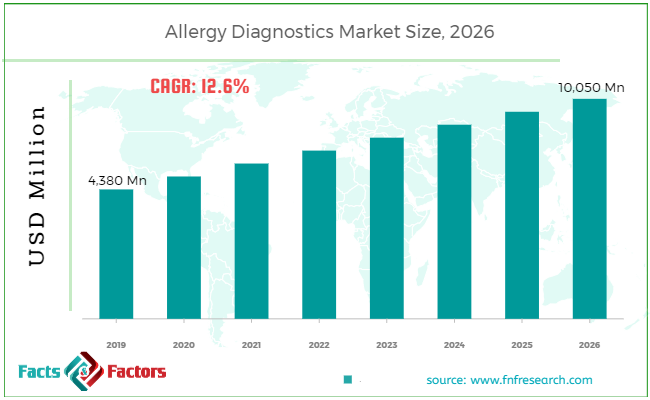Search Market Research Report
Allergy Diagnostics Market Size, Share Global Analysis Report, 2019 – 2026

Allergy Diagnostics Market by Product Type (Luminometers, Assay Kits, Immunoassay & ELISA Analyzers, and Services), by Allergen Type (Inhaled, Food, and Others), and by End-User (Hospitals, Diagnostic Laboratories, Academic Research Institutes, and Others): Global Industry Perspective, Comprehensive Analysis, and Forecast 2019 – 2026
Industry Insights
[180+ Pages Report] According to the report published by Facts Factors, the global allergy diagnostics market size was worth around USD 4,380 Million in 2019 and is predicted to grow to around USD 10,050 Million by 2026 with a compound annual growth rate (CAGR) of roughly 12.6% between 2020 and 2026. The report analyzes the global allergy diagnostics market drivers, restraints/challenges, and the effect they have on the demands during the projection period. In addition, the report explores emerging opportunities in the allergy diagnostics market.

The allergy diagnostics market report analyzes and notifies the industry statistics at the global as well as regional and country levels to acquire a thorough perspective of the entire allergy diagnostics market. The historical and past insights are provided for FY 2016 to FY 2019 whereas projected trends are delivered for FY 2020 to FY 2026. The quantitative and numerical data is represented in terms of value (USD 10,050 Million) from FY 2016 – 2026.
 Key Insights from Primary Research
Key Insights from Primary Research
- As per our primary respondents, the global allergy diagnostics market is set to grow annually at a rate of around 12.6%.
- It was established through primary research that the global allergy diagnostics market was valued at around USD 4,380 Million in 2019.
- The “inhaler” category, on the basis of allergen type segmentation, was the leading revenue-generating category in 2019.
- Based on the region, North America was the leading revenue-generating category in 2019.
 Key Recommendations from Analysts
Key Recommendations from Analysts
- As per our analysis, the global allergy diagnostics market is growing at high CAGR and various end-use industries are aware of this potential market and applications of the allergy diagnostics.
- Growing at a CAGR around 12.6%, the global allergy diagnostics market provides numerous opportunities for all of the involved stakeholders across the entire value chain.
- Our analysts have identified inhaler segment will be dominating for global allergy diagnostics market in terms of allergen type.
- As per our analysis, North America is expected to account for maximum revenue share, in the target market.
The quantitative data is further underlined and reinforced by comprehensive qualitative data which comprises various across-the-board market dynamics. The rationales which directly or indirectly impact the allergy diagnostics industry are exemplified through parameters such as growth drivers, restraints, challenges, and opportunities among other impacting factors.
Throughout our research report, we have encompassed all the proven models and tools of industry analysis and extensively illustrated all the key business strategies and business models adopted in the allergy diagnostics industry. The report provides an all-inclusive and detailed competitive landscape prevalent in the allergy diagnostics market.
 Report Scope
Report Scope
Report Attribute |
Details |
Market Size in 2019 |
USD 4,380 Million |
Projected Market Size in 2026 |
USD 10,050 Million |
CAGR Growth Rate |
12.6% CAGR |
Base Year |
2019 |
Forecast Years |
2020-2026 |
Key Market Players |
Thermo Fisher Scientific, Inc., Siemens Healthineers, R-Biopharm AG, Lincoln Diagnostics, Inc., Hitachi Chemical Co Ltd, HOB Biotech Group Co, Danaher Corporation, bioMérieux., and Others |
Key Segment |
By Product, Type, End User, and Region |
Major Regions Covered |
North America, Europe, Asia Pacific, Latin America, and the Middle East & Africa |
Purchase Options |
Request customized purchase options to meet your research needs. Explore purchase options |
The report utilizes established industry analysis tools and models such as Porter’s Five Forces framework to analyze and recognize critical business strategies adopted by various stakeholders involved in the entire value chain of the allergy diagnostics industry. The allergy diagnostics market report additionally employs SWOT analysis and PESTLE analysis models for further in-depth analysis.
The report study further includes an in-depth analysis of industry players' market shares and provides an overview of leading players' market position in the allergy diagnostics sector. Key strategic developments in the allergy diagnostics market competitive landscape such as acquisitions & mergers, inaugurations of different products and services, partnerships & joint ventures, MoU agreements, VC & funding activities, R&D activities, and geographic expansion among other noteworthy activities by key players of the allergy diagnostics market are appropriately highlighted in the report.
The demand for allergy diagnostics is largely dictated by the unique advantages of allergy diagnostics processes, the increase in innovative techniques in the commodity sector and in opposite end-use industries, and the lack of well-being and sterilization issues for packaged foods. Allergy diagnostics has been increasingly used for the development of self-purifying channels and for the cleaning of various products, in particular meat and poultry bundling. This has encouraged the growth of the sector.
Impressive financial investments involved with the production of cost plasma technologies and their small distribution are likely to hinder the growth of the sector. However, the growing uses of allergy diagnostics in different end-use enterprises, for example, for example, nourishment, agribusiness, and polymers, and plastics sections across developing countries are the components boosting the market growth.
The worldwide allergy diagnostics industry has been segmented on the basis of product type, end-user, allergen type, and region. The Product type segment is divided into luminometers, immunoassay and ELISA analyzer, assay kits, and services. Further, the allergen type segment is classified as food, inhaled, and others. Additionally, the end user segment is classified as hospitals, academic research institute, diagnostic laboratories, and others.
 Some of the essential players operating in the market are:
Some of the essential players operating in the market are:
- Thermo Fisher Scientific Inc.
- Siemens Healthineers
- R-Biopharm AG
- Lincoln Diagnostics Inc.
- Hitachi Chemical Co Ltd
- HOB Biotech Group Co
- Danaher Corporation
- bioMérieux
The taxonomy of the allergy diagnostics Market by its scope and segmentation is as follows:
 Product Type Segment Analysis
Product Type Segment Analysis
- Luminometers
- Assay Kits
- Immunoassay and ELISA Analyzers
- Services
 Allergen Type Segment Analysis
Allergen Type Segment Analysis
- Inhaled
- Food
- Others
 End-User Segment Analysis
End-User Segment Analysis
- Hospitals
- Diagnostic Laboratories
- Academic Research Institutes
- Others
 By Regional Segment Analysis
By Regional Segment Analysis
- North America
- The U.S.
- Canada
- Europe
- Germany
- The UK
- France
- Spain
- Italy
- Rest of Europe
- Asia Pacific
- China
- Japan
- India
- South Korea
- Southeast Asia
- Rest of Asia Pacific
- Latin America
- Brazil
- Mexico
- Rest of Latin America
- Middle East & Africa
- GCC
- South Africa
- Rest of Middle East & Africa
Industry Major Market Players
- Thermo Fisher Scientific Inc.
- Siemens Healthineers
- R-Biopharm AG
- Lincoln Diagnostics Inc.
- Hitachi Chemical Co Ltd
- HOB Biotech Group Co
- Danaher Corporation
- bioMérieux
Frequently Asked Questions

Copyright © 2024 - 2025, All Rights Reserved, Facts and Factors


